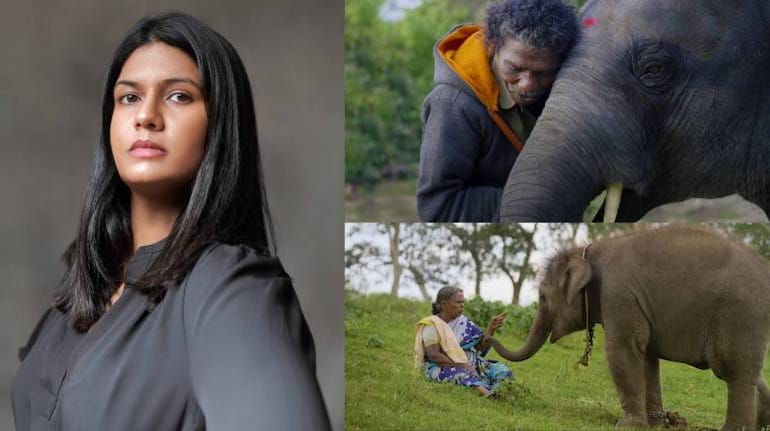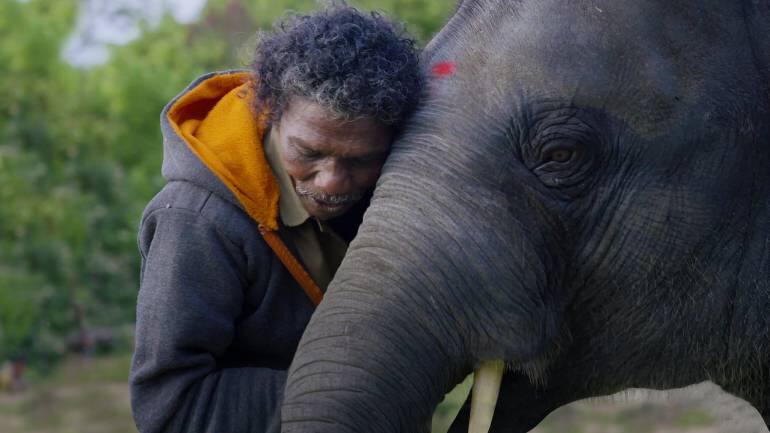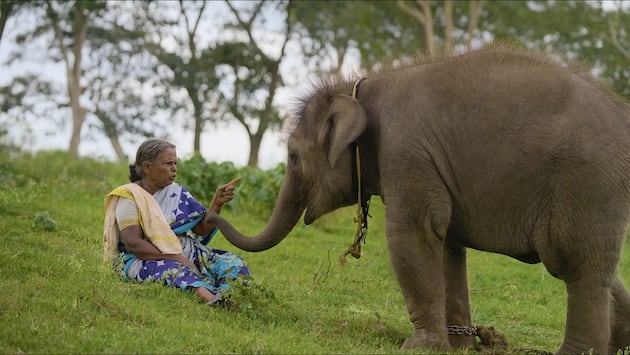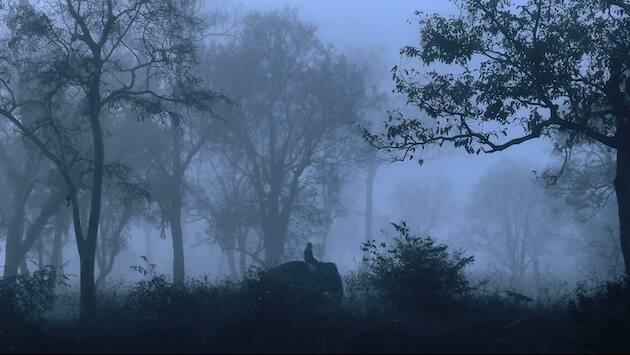



As a young child, Oscar winner Kartiki Gonsalves grew up in the Nilgiris and at one-and-half years, camped out with her parents in the wilderness. A wildlife photography enthusiast since she was 15, Gonsalves donned the hats of a salesgirl at Fabindia, gym assistant and an advertising employee, before becoming director-cinematographer-executive producer of the Oscar-winning Netflix short documentary, The Elephant Whisperers, produced by Sikhya Entertainment.
In her first film, Gonsalves, who lives in Ooty, Tamil Nadu, takes the help of a tribal couple — Bellie and Bomman — living in the Mudumalai Tiger Reserve in the state and their special relationship with Raghu and Ammu, the two orphaned elephant calves they care for in an elephant rehabilitation camp, to drive home the message of a renewed look at the relationship between humans and animals and the larger issue of respecting nature and protecting the planet.
The Elephant Whisperers won the Oscar for Best Documentary Short, on March 12 (March 13 in India), 2023.
Who's the Indian cinematographer whose film won an Oscar on his second Academy Awards outing?
In this interview, Kartiki Gonsalves talks about Asian elephants and indigenous communities, when the Theppakadu Elephant Camp started, and the need to think beyond our own selves to help the planet. Edited excerpts:
What has the Oscar nomination for the Best Documentary Short meant for you and your film project?On behalf of Bellie, Bomman, Raghu and Ammu (the protagonists in The Elephant Whisperers), I have to admit that our team is absolutely thrilled to receive this great honour. The Oscar shortlist and nomination are helping create more awareness and connection to elephants and other living beings that we share our spaces with. I am extremely grateful to Netflix for believing in this unique family story about the beautiful sacred bond between human and animal. The movie has gone out to 231 million subscribers in 90 countries and multiple languages. I have a whole album of paintings and sketches made by so many people we have received from across the world, which I will be releasing on Instagram soon. The film has connected people across the world. It comes to the question of how powerful filmmaking and storytelling is and how a small story with a global message has reached people across the globe in spite of being a local story from the heart of India.
I grew up in the Nilgiris as a young child. I have always been telling stories through photography in nature, wildlife and conservation. Six years ago, I was moving from Bengaluru to Ooty, when I met Bomman and Raghu while driving through the Mudumalai Tiger Reserve in the Nilgiris in Tamil Nadu. They were walking on the side of the road. Bomman, an elephant caregiver, was taking Raghu, an elephant calf, to the river for a bath. I pulled my car over and joined them. I noticed how close Raghu was to Bomman and the kind of relationship they shared. This tiny little calf, which was three months old, was orphaned after his mother got electrocuted while their herd was looking for food and water during a prolonged drought. It was like a father-son relationship. You could see how much Raghu craved for the love and care from Bomman. The film started out as a personal journey. I didn't know then that I was going to make a documentary on them. It was just me enjoying time with an elephant calf and its caregiver.
ALSO READ: Oscars 2023 | Who’s the Indian cinematographer going to the Academy Awards second year in a row?
 Elephant caregiver Bomman, who belongs to the Kattunayakan indigenous community, with the elephant calf Raghu (Photo courtesy Kartiki Gonsalves)What is the story of this beautiful co-existence of the Kattunayakan tribal community that cares for abandoned and orphaned baby elephants in the Mudumalai Tiger Reserve?
Elephant caregiver Bomman, who belongs to the Kattunayakan indigenous community, with the elephant calf Raghu (Photo courtesy Kartiki Gonsalves)What is the story of this beautiful co-existence of the Kattunayakan tribal community that cares for abandoned and orphaned baby elephants in the Mudumalai Tiger Reserve?I was interested in the culture of the Kattunayakan community in the Nilgiris to which Bomman belonged. I wanted to understand why Raghu was orphaned, which opened up a lot of questions for me. During the time I spent with them, I developed a personal bond with Raghu. Later, I met Bellie (elephant caregiver and wife of Bomman) and realised she had an emotional maternal side towards Raghu. It was an unusual family dynamic that was presented in front of my eyes. During this entire time, I was recording on my phone camera and using my DSLR camera. I was recording it because it was very special to me. I recorded this intimate footage of this curious bond between Bomman, Bellie and Raghu. It was special.
How is the human-animal conflict affecting the population of Asian elephants in the country?We have a deeper human-animal conflict in India. It is little known to people in India that our Asian elephant is endangered with only around 35,000-40,000 elephants left. It is a very grim situation. They are lost to human-animal conflict and poaching among other reasons. I think because of the current situation of Asian elephants in India due to climate change and encroachment of land, it was sort of a bitter-sweet story when I learnt how Raghu was orphaned. His mother had wandered into a nearby village while their herd was in search of food and water during a prolonged drought. The mother got electrocuted and she died almost instantly. Soon after Raghu went and joined a herd of cows. He couldn't get enough food because cows don't consume as much as elephants. That is how he went to a nearby village and started stealing fruit from local shops. He got attacked by stray dogs which chewed off his tail and he became sick and weak. His wounds started getting infected. That is when the local community stepped in and called the forest department, which assigned Bomman to the care of Raghu. He nursed the calf back to good health so that he could bring him to the elephant rehabilitation camp.
What does the life and work of the Kattunayakan community, which cares for the abandoned and orphaned elephants, tell us about protecting nature?The Kattunakayan is one of the tribal communities living inside the forest, the others include the Malasar and the Betta Kurumba communities. A lot of these tribes are hunter-gatherers that originate in the Nilgiris which is much older than the Himalayas. The Nilgiris is home to many indigenous communities. The Nilgiris biosphere covers the states of Tamil Nadu, Karnataka and Kerala. It is a massive space and the largest contiguous forest for the Asian elephant in the world. The language that the Kattunayakan community speaks is a mixture of Tamil, Kannada and Malayalam. When the movie came out, everyone recognised it was a mixture of all the three languages, but different. Only 1,700 members of the Kattunayakan community are left today. It is very special that we were able to have parts of the film in the Kattunayakan language. We had translators working with us. Bomman and Bellie spoke to each other, to others in their community and the elephants in the Kattunayakan language. They talked to us in Tamil. That is why the film is in Kattunayakan and Tamil languages. There is a whole lot to learn from them in many ways about how to protect nature.
 Elephant caregiver Bellie and orphaned elephant calf Baby Ammu in an elephant rehabilitation camp in the Mudumalai Tiger Reserve, the largest contiguous forest for the Asian elephant in the world. (Photo courtesy Kartiki Gonsalves)Bellie says in the movie, 'For us the well-being of the forest is all that matters. We live off the forest and protect it, we don't take anything more than necessary.' These words come off as bigger statements than those made by powerful heads of state and famous environmentalists and conservationists.
Elephant caregiver Bellie and orphaned elephant calf Baby Ammu in an elephant rehabilitation camp in the Mudumalai Tiger Reserve, the largest contiguous forest for the Asian elephant in the world. (Photo courtesy Kartiki Gonsalves)Bellie says in the movie, 'For us the well-being of the forest is all that matters. We live off the forest and protect it, we don't take anything more than necessary.' These words come off as bigger statements than those made by powerful heads of state and famous environmentalists and conservationists.We really have to think about conservation in a much larger perspective. The people who live within the forests and live on the periphery of the forests are the indigenous people who have been co-existing with animals for centuries. They have a plethora of information on how to live in the wild and live off the land by taking only what they need. One of the things that drew me to the story to begin with was how Bomman and Bellie approached life and the way they respected the forest. That is something we all need to learn as humans. People tend to look at how our life could be better. But it is not about that anymore. I think we are at a stage where the planet really needs our help.
Do elephant caregivers receive help from the government?The Theppakadu Elephant Camp for rehabilitation of elephants in Mudumalai forest was started 140 years ago by the British. It was initially a timber camp where the elephants were used to carry logs. It later became a rehabilitation camp for elephants because of human-animal conflict and the rescue of temple elephants. It is a beautiful synergy between the forest department of Tamil Nadu government and the indigenous communities that we don't see often in India. The forest department recognised that the strengths of the indigenous people was something that was required to manoeuvre in the forest. In many places, the government removed indigenous communities from the forest. Here they didn't. Bomman and Bellie live in the core area of the forest along with the other indigenous groups. A lot of them work together with the forest department.
 The Theppakadu Elephant Camp in the Mudumalai Tiger Reserve dates back to 140 years ago during the British rule. (Photo courtesy Kartiki Gonsalves)You are a cinematographer (one of the four cinematographers of The Elephant Whisperers), natural history photographer and now a film director. What led you to make a documentary to start your career as a filmmaker?
The Theppakadu Elephant Camp in the Mudumalai Tiger Reserve dates back to 140 years ago during the British rule. (Photo courtesy Kartiki Gonsalves)You are a cinematographer (one of the four cinematographers of The Elephant Whisperers), natural history photographer and now a film director. What led you to make a documentary to start your career as a filmmaker?The first time I ever camped out in the wilderness was when I was 18-months-old with my parents. My mother helped me understand wildlife culture, my father was also a photographer and my grandmother was a naturalist who took school children to wild spaces. I have been taking photographs since I was a 15 year's old. I always wanted to be a wildlife photographer. But I realised that wildlife photography and social documentary in India didn't have a space for a career. That sort of pushed me into exploring other ways. I got an offer for a short documentary in Uttarakhand and learnt how to use the moving camera. I realised it was a very powerful mode of telling stories that reached out to the world. That is when I turned to filmmaking. When I first started the The Elephant Whisperers project, I approached Netflix. I told them I would direct the movie. I showed them my photography portfolio and they said this is beautiful, why don't you do it yourself. I started the journey with the movie in 2017. We shot over the past five years. In the end, we had 450 yards (412 metre) of footage, which became a 40-minute film.
Discover the latest Business News, Sensex, and Nifty updates. Obtain Personal Finance insights, tax queries, and expert opinions on Moneycontrol or download the Moneycontrol App to stay updated!
Find the best of Al News in one place, specially curated for you every weekend.
Stay on top of the latest tech trends and biggest startup news.